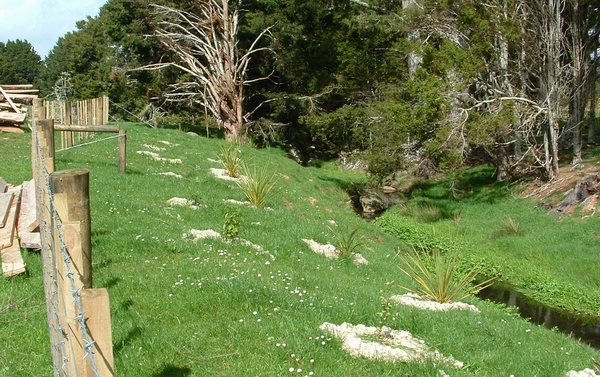Riparian planting
Get information on how to get your riparian planting right, and protect our valuable water resource.
Planting
Grass buffer strips in the fenced riparian zone can be very effective at filtering contaminants in paddock run-off. However, planted riparian margins can also have other benefits such as:
- Cooling the water to provide better habitat for aquatic species;
- Providing corridors linking habitat for native species;
- Providing shade and shelter for stock;
- Making stock management easier; and
- Improving the attractiveness of your property.
Planting guides
For help planning what to plant where, contact one of our land management advisors or see our fact sheets, riparian planting guides and resources to help you with your planting.
Weed control
In the absence of stock grazing there is the potential for weeds to get established within the fenced riparian margin, especially if there's very little ground cover. A regular weed control programme is recommended, which council staff can provide advice on.
Check out our weed control information in the Pest Control Hub.
Pest animal control
Undisturbed riparian areas can also become havens for pest animals, such as stoats, weasels, rats, wild cats and hedgehogs. These can be trapped or poisoned. Joining or establishing a Landcare group in your area can provide useful support for managing pests.
Find our pest animal information in the Pest Control Hub or contact the council's biosecurity team for more advice on pest control.
Contact a land management advisor
For more information, contact a land management advisor on 0800 002 004 or email info@nrc.govt.nz One of our land management team can visit your property and offer free advice on funding and sustainable land management actions that could improve water quality on your property.

This short video series follows a planting project on Good Eggs farm, to improve the land and reduce sediment going into local streams.
It’s one of many similar events happening around the area to improve water quality in the Mangere catchment, which ultimately flows into the Kaipara Harbour.
And it’s a great example of local communities working together to protect and restore Northland’s environment.
Episode 1 - Good Eggs
Check out the story of a planting project on Good Eggs farm, to improve the land and reduce sediment going into local streams.
In this episode, farm owner Bridget Robertson talks about the win-win of taking a piece of land that can’t be farmed back to its natural state.
Episode 2 - Enviroschools and Kokopu School
In this episode, NRC Enviroschools Facilitator Eden Hakaraia and Kokopu School Principal Mark Ashcroft talk about the value for children and seeing how they can make a difference.
Episode 3 - Royce Kokich
In this episode Royce Kokich from the Mangere Catchment Group talks about the group’s vision to improve water quality from the Mangere River right through to the Kaipara Harbour.
Episode 4 - John Ballinger
In the last episode of this series, Land Management Advisor John Ballinger talks about how the council is supporting landowners to improve their environmental performance.
